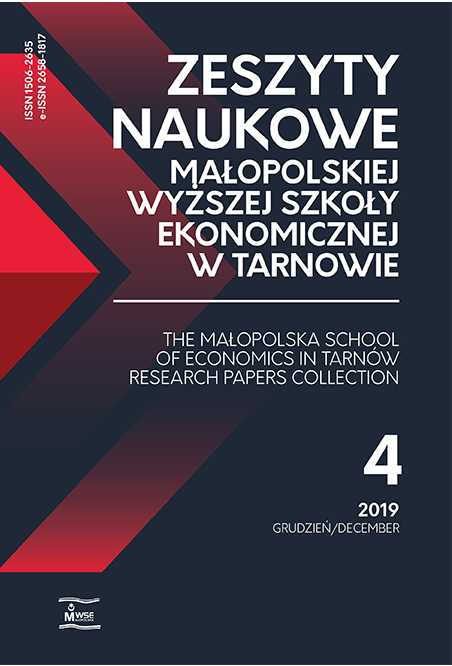Abstract
The purpose of the article is to identify and characterize IT instruments and tools used in customer relationship management (CRM) and to present the results of empirical research. In particular, the article presents the essence and elements of the customer relationship management system (CRM), determines its importance in the functioning of the company and shaping business relations with stakeholders. Especially, a lot of space is devoted to a discussion on information technology in the development of CRM. A selection of more important IT tools supporting CRM are characterized, such as the database management subsystem, Internet services, social media (social CRM), cloud computing, ERP/MRP III applications and Big Data, highlighting their advantages and disadvantages and applications. The empirical section of the work contains a description, including the significance and benefits of use, of e-learning in the development of the CRM system and the conditions for its implementation.
References
Adamczyk, J. (2002). CRM w ujęciu klasycznym i internetowym [online, accessed: 2009-01-30]. E-marketing.pl. Strategie marketingu internetowego. Retrieved from: http://www.e-marketing.pl/artyk/artyk63.php.
View in Google Scholar
Buchowska, D. (2006). CRM – strategia i technologia. Gdańsk: Wydawnictwo Uniwersytetu Gdańskiego. ISBN 8373264116.
View in Google Scholar
Burnett, K. (2002). Relacje z kluczowymi klientami: analiza i zarządzanie. Kraków: Oficyna Ekonomiczna. ISBN 8388597752.
View in Google Scholar
Cegielski, M. (2002). CRM – nowe podejście do klienta [online, accessed: 2003-01-18]. Retrieved from: www.infoflow.pl/artykuly/marketing/m_crm_nowe_podejscie_do_klienta.html.
View in Google Scholar
CRM jako system informatyczny. (2019). GoNet CRM [online, accessed: 2019-07-07]. Retrieved from: https://blog.gonetcrm.pl/crm-jako-system-informatyczny/.
View in Google Scholar
Evolpe. (2019). Czym różni się CRM w modelu SaaS od CRM w chmurze? [online, accessed: 2019-09-20]. Evolpe.pl. Poznań: Winogrady Business Center. Retrieved from: https://evolpe.pl/czym-rozni-sie-crmw-modelu-saas-od-crm-w-chmurze/.
View in Google Scholar
Frąckiewicz, E., Rudawska, E. (2005). CRM jako narzędzie zarządzania relacjami z klientem na rynku usług. Szczecin: Wydawnictwo Naukowe Uniwersytetu Szczecińskiego. ISBN 8372414823.
View in Google Scholar
Gemius. (2019). E-commerce w Polsce [online, accessed: 2019-07-07]. Warszawa: Gemius Polska. Retrieved from: https://www.gemius.pl/wszystkie-artykuly-aktualnosci/raport-e-commerce.html.
View in Google Scholar
GUS. (2012). Biuletyn Statystyczny: styczeń–grudzień 2012 [online, accessed: 2013-01-15]. Warszawa: Główny Urząd Statystyczny. Retrieved from: https://stat.gov.pl/obszary-tematyczne/inne-opracowania/informacje-o-sytuacji-spoleczno-gospodarczej/biuletyn-statystyczny-styczen-grudzien-2012-r-,4,10.html.
View in Google Scholar
Kaszyca, K., Zacharski, J. (2015). Social CRM jako determinanta rozwoju przedsiębiorstw. Zeszyty Naukowe Politechniki Częstochowskiej. Zarządzanie, 20, 195–202.
View in Google Scholar
Kiełtyka, L. (2002). Komunikacja w zarządzaniu. Techniki, narzędzia i formy przekazu informacji. Warszawa: Placet. ISBN 838542878X.
View in Google Scholar
Kisielnicki, J. (2014). Zarządzanie i informatyka. Warszawa: Placet. ISBN 9788374881845.
View in Google Scholar
Kowalczyk, M., Narutowska, A. (2013). Zarządzanie relacjami z klientem (CRM) jako element struktury logistycznej. Logistyka, 5, 102–105.
View in Google Scholar
Kozioł, M. (2005). Wspomaganie informatyczne procesów komunikacji marketingowej w przedsiębiorstwie. Zeszyty Naukowe Wyższej Szkoły Umiejętności w Kielcach, 15(1), 187–200.
View in Google Scholar
Kozioł, M. (2018). Wykorzystanie e-learningu w procesie szkolenia pracowników małych i średnich przedsiębiorstw. Pelplin: Wydawnictwo Bernardinum. ISBN 9788381273299.
View in Google Scholar
Mierzejewski, M. (2001). Hurtownie danych w praktyce [online, accessed: 2003-09-23]. Modern Marketing, 6. Retrieved from: www.modelmarketing.pl/archiwum.
View in Google Scholar
Newell, F. (2002). Lojalność.com. Zarządzanie relacjami z klientami w nowej erze marketingu internetowego. Kraków: IFC Press. ISBN 8391351971.
View in Google Scholar
O’Reilly, T. (2005). What is Web 2.0: Design patterns and business models for the next generation of software [online, accessed: 2019-07-07]. O’Reilly Media Inc. Retrieved from: http://www.oreillynet.com/pub/a/oreilly/tim/news/2005/09/30/what-is-web-20.html.
View in Google Scholar
Olszak, C. M., Bartuś, K., Bilewicz, G. (2015). Wykorzystanie systemów klasy CRM w działalności biznesowej przedsiębiorstw – wybrane wyniki badań. Studia Ekonomiczne. Zeszyty Naukowe Uniwersytetu Ekonomicznego w Katowicach, 232, 178–192.
View in Google Scholar
Process4E. (2001). Raport – CRM w Polsce [online, accessed: 2008-12-04]. Warszawa: Process4E SA. Retrieved from: http://crm.pl/files/Raport%20CRM%20(Process4E).pdf.
View in Google Scholar
Sokołowski, T. S. (2001). Oprogramowanie CRM dla działów handlu i marketingu. Manager, 5, 11–24.
View in Google Scholar
Sołtysik-Piorunkiewicz, A. (2008). Zarządzanie relacjami z klientem z wykorzystaniem techniki customer care – charakterystyka systemów CRM. Zeszyty Naukowe Wyższej Szkoły Humanitas w Sosnowcu, 2, 71–79.
View in Google Scholar
Sudolska, A. (2013). Social CRM jako nowoczesna koncepcja biznesowa. Acta Universitatis Nicolai Copernici. Zarządzanie, 40(413), 25–37.
View in Google Scholar
Wurm, S. (2002). Korporacyjna Architektura Informacyjna – podstawa CRM [online, accessed: 2004-01-29]. Retrieved from: infflow.pl/artykuly/marketing/m_infovide_podstawy_crm.html.
View in Google Scholar
© Copyright by Małopolska School of Economics in Tarnów. The articles are available under the Creative Commons Attribution NonCommercial-NoDerivatives 4.0 International License


